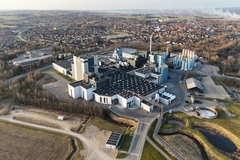
- Industry news
Industry news
- Category news
Category news
- Reports
- Key trends
- Multimedia
Multimedia
- Journal
- Events
- Suppliers
- Home
- Industry news
Industry news
- Category news
Category news
- Reports
- Key trends
- Multimedia
Multimedia
- Events
- Suppliers
Same Great Salad in Smaller Packages: New Subway Salad Bowl Reduces Impact on Environment, Simple Changes Lead to Big Gains in Conserving Resources

First, to make the SUBWAY salad bowl as green as possible, the materials were changed from rarely recycled OPS to PETE, the number-one most recycled plastic.

30/04/09 30/04/09 Sandwich chain SUBWAY, known for its health-focused menu, is turning its efforts toward a healthier environment. With the help of PWP Industries, SUBWAY is slimming down and greening up its plastic salad bowls and lids.
"Our business is about serving convenient, yet healthy foods. We have a responsibility to reduce our impact on the environment so that we can continue to serve people around the world in a sustainable way," says SUBWAY World Headquarters spokesperson Elizabeth Stewart, Director of Marketing & Sustainability. "Simple actions can create the greatest change. By switching our salad bowl materials to a more environmentally-friendly profile and reducing the amount of plastic needed to produce them, we can attain significant conservation of our natural resources."
"With SUBWAY, we saw an opportunity to re-design their salad packaging to support their sustainability initiative," says Ira Maroofian, President and COO, PWP Industries. "The challenge was to provide a solution that encompassed materials, package dimensions and still create an innovative product that communicates perceived premium value to the consumer eyes."
PWP approached the SUBWAY salad bowl re-design in two phases, both of which were aimed at improving the environmental profile of the bowl.
First, to make the SUBWAY salad bowl as green as possible, the materials were changed from rarely recycled OPS to PETE, the number-one most recycled plastic. The PETE used in the SUBWAY bowl isn't just recyclable, it uses PETE resin combined with 10 percent post-consumer recycled content (PCR), instead of 100 percent virgin resin. This recycled content mainly consists of soda and water bottles that have been reclaimed, washed and recycled back into usable FDA compliant raw materials to use in PWP's packaging. This process diverts approximately 270,000 lbs. of plastic from landfills every year.
In the next phase, a strategic package re-design reduced the amount of plastic used and, at the same time, achieved a dramatically different look for the bowl. By introducing more swirls, which reduce surface area, it takes less plastic to produce than a straight-walled bowl. The second phase also addressed reducing the diameter of the package from 10 inches to 9 while still maintaining the same 32 oz. volume.
With just these few insightful changes, the new salad bowl will:
- Reduce the amount of plastic material used annually by 711,780 pounds and save the equivalent of 5,488 barrels of oil annually
- Reduce 19,540 cases of corrugate annually
- Reduce the carbon footprint by 20.9 percent or 84.8 kilograms of carbon dioxide equivalent (CO2e) per thousand containers produced.
In another step toward Sustainability, PWP, in the second quarter of 2009, will open one of the first in house plastics recycling facilities by a thermoforming company. PWP will work with Coca-Cola Recycling LLC to recycle PETE post-consumer bottles into FDA compliant resin for food contact.
"Developing our own recycling facility is the right thing to do as the United States, the number one consumer in the world, faces ecological and energy issues on a global level," says Maroofian. "Recycling PETE bottles will allow PWP to increase its product range containing post-consumer resin, save energy, reduce carbon dioxide emissions and keep plastic materials out of landfills. We are fortunate to be able to work with Coca-Cola Recycling LLC who is as committed as we are to a greener future for our planet."










